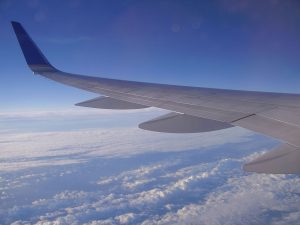
Ever notice how most airplanes have curved tips at the end of their wings? Known as winglets, they are a common feature of commercial jets. Boeing 737 jets and Airbus A320 jets, for instance, have winglets. Their wings aren’t completely straight. Instead, they curve upwards at the end.
#1) Introduced With the Learjet 28
Winglets were originally introduced with the Learjet 28. The successor to the Learjet 25, the Learjet 28 was a business jet that accommodated six to eight passengers. One of the key differences between the Learjet 28 and the Learjet 25 was winglets. The Learjet 28 was the first airplane to feature winglets.
#2) Improves Fuel Efficiency By 4 to 6%
Why do airplanes like the Learjet 28 have winglets exactly? The main benefit of these wingtip devices is reduced fuel consumption. Winglets improve fuel efficiency by an average of 4% to 6%. Airplanes with winglets consume less fuel than their counterparts with straight wings. As a result, most commercial airlines use winglets on their jets to save money on fuel expenses.
#3) Environmentally Friendly
Not only do they help commercial airlines save money on fuel expenses, but winglets are also environmentally friendly. Airplanes release carbon dioxide into the atmosphere. It’s a byproduct of their engines’ combustion process. Airplanes with winglets, though, consume less fuel, resulting in less carbon dioxide emissions.
#4) Reduce Drag
Winglets are designed to reduce drag. This is essentially how they improve fuel efficiency and, thus, promote environmentally friendliness. Their vertical shape minimizes air vortices. Normally, strong swirling vortices of air form at the tips of an airplane’s wings. Winglets work by weakening these air vortices, which in turn reduces drag and improves fuel efficiency.
#5) Not All Airplanes Have Them
While they are common, not all airplanes have winglets. Winglets offer advantages like improved fuel efficiency, but they also make it more difficult for airplanes to fit into hangers. Another potential drawback of winglets is weight. They make airplanes heavier. Of course, the tradeoff of improved fuel efficiency is typically worth the added weight.
#6) Different Types of Winglets
There are several different types of winglets. Blended winglets, for instance, are characterized by a smoothly curved design where the tips integrate into the main body of the wings. Sharklets, on the other hand, are found on Airbus jets. There are also split scimitar winglets that use a downward-facing design to further improve aerodynamics.



